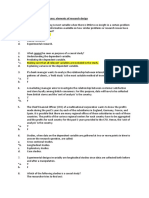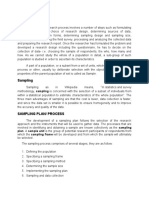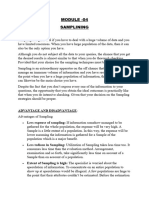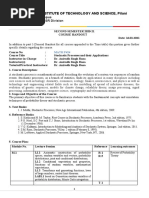Chapter 13: Sampling
Chapter 13: Sampling
Uploaded by
Mida SonbayCopyright:
Available Formats
Chapter 13: Sampling
Chapter 13: Sampling
Uploaded by
Mida SonbayOriginal Description:
Original Title
Copyright
Available Formats
Share this document
Did you find this document useful?
Is this content inappropriate?
Copyright:
Available Formats
Chapter 13: Sampling
Chapter 13: Sampling
Uploaded by
Mida SonbayCopyright:
Available Formats
CHAPTER 13: SAMPLING
CHAPTER 13: SAMPLING
If the data is not collected from the people, events, or objects that can provide
the correct answer to solve the problem, the survey will be futile. The election process
the right of individuals, objects, or events as a representative for the entire population is called " samples ".
Population, Element, Sample, Sampling Unit, and Subject
Population
Population refers to the group as a whole, incident / event, or something
the researchers are interested to be investigated / researched. For example, if the CEO of a computer company
wants to know what types of advertising strategies employed by computer companies in
Silicon Valley, then all computer companies domiciled there will be
population.
Element
Element is a member of the population. For example, if the 1000 workers in a particular organization
The population of the study, every worker in it's element. Census
a calculation of all elements in the human population.
sample
The sample is the subject of the population. The sample consisted of a number of members chosen from
population. Some, but not all elements will form the sample population. Examples of
1000 workers, 200 workers were sampled from a study.
sampling Unit
The sampling unit is an element or set of elements that are available to be selected in a few
menyampel process stage.
Subject
The subject is a member of the sample, as the element is a member of
population. Suppose that 200 workers is a sample from a population. Each of the 200 workers of
The sample of a subject in a study.
Parameters
OMAR SHAZAKI dilaga (A311 11 259)
CHAPTER 13: SAMPLING
The characteristics of the population such as (population), (standard deviation of the population), and 2 (variance
population) called a parameter.
Reasons for Sampling
The reason for using a sample, rather than collecting data throughout pupolasi already
very clear. In a study involving hundreds and even thousands of elements, practically
impossible to collect data, test, or examine each element. This bus is done
but will cost, time, and energy. Research on a sample and not the entire
population elements sometimes also very likely to produce more reliable results.
Representativeness of Samples
Kebuutuhan to select the appropriate sample for the study was not excessive. We
know that rarely sample into the exact replica of the population where the sample was taken. Simply,
the sample does not reflect the exact population
Normality of Distributions
Attributes or characteristics of the population generally normal distribution. Simply, attributes such as height,
most people will be grouped average height. Only a fraction short
and tall. When the nature of the population does not overrepresented or underrepresented in the sample
it will obtain a representative sample.
The Sampling Process
Steps in taking the sample:
1. Limiting the population.
2. Determining the sample frame.
3. Determining the sample design.
4. Determine the appropriate sample size.
5. Carry out the sampling process.
probability Sampling
When elements of the population have a known chance of being selected as a subject in the sample,
then we choose the design of the sampling by means of probabilities. Sampling
how probabilities can be a simple random sampling or complicated.
Unrestricted or Simple Random Sampling
OMAR SHAZAKI dilaga (A311 11 259)
CHAPTER 13: SAMPLING
Each element of the population has a known and equal chance of being selected as a subject.
This sampling design has the least bias and give a generalization of the most
large. However, the sampling process can be cumbersome and expensive.
Complex Probability Sampling
The sampling procedure in this way, providing a viable alternative and sometimes
more efficient than the design is not limited. There are five ways to design the sampling method
The most common complex probability sampling is systematic, decision
random sample strata, cluster sampling, the sampling area, and twice
sampling.
Sampling nonprobability
In the sampling design nonprobabilitas way, the probability of elements in the population
being selected as a subject of unknown samples. This means that the findings of the study
of the samples can not be reliably generalized to the population.
Convenience Sampling
Pengoleksian information of members of the population that could be easy to prove.
purposive sampling
Limited to certain types of people who can provide the desired information, either
because they are the only ones who have it, or they confirm some
criteria set by the researchers. There are two types of models, namely judgment sampling and
quota sampling.
Examples of When Certain Sampling Design Would Be Appropriate
Simple Random Sampling: The findings are common in a population.
Stratified Random Sampling: Difference information required in the various strata
in the population.
Systematic Sampling: If the frame sampling large, and a list of elements easily
available in one place.
Cluster Sampling: Various types studied group at a time.
Area Sampling: The research objective is limited to specific regions or localities.
Double Sampling: Wanting more information at a small extra cost.
OMAR SHAZAKI dilaga (A311 11 259)
CHAPTER 13: SAMPLING
Convenience Sampling: Want to get information "quickly" to get a "taste"
on a phenomenon or variable interest.
Judgment Sampling: There was input specific information on the important topic of research.
Quota sampling: The involvement of all the groups studied, small groups
the number is not negligible.
Sampling in Cross-Cultural Research
In a cross-cultural studies, we must be sensitive to the issue of selection of samples that fit in
different countries. The nature and type of organization studied, whether the subject is derived from the area
rural or urban, and the type of sampling design used, all should
similar in the different countries to allow a true comparison.
Issues of Precision and Confidence in Determining the Sample Size
Precision
Accuracy refers to how close our estimate population characteristics
in fact. Usually we will estimate the population parameter is within a range,
based on the estimated sample.
confidence
Confidence shows how confident that we estimate will actually apply to
population.
Sample Data, Precision, and Confidence in Estimation
Accuracy and confidence is an important issue in sampling because when we
use sample data to draw conclusions about the population, we hope to
hit a target and determine the level of possible errors. Because the level of point estimates
does not provide a measure of the probability of error, we performed the assessment interval to
ensure a relatively accurate assessment of the population parameter.
Trade Off Between Confidence and Precision
Researchers need to consider at least four aspects when making decisions regarding
The sample size of the study: (1) How much rigor needed in assessing
the characteristics of the population studied. (2) How much confidence that is really needed. (3)
To what extent the variability of the characteristics of the population studied? (4) How do the cost benefit analysis
of increasing the sample size?
OMAR SHAZAKI dilaga (A311 11 259)
CHAPTER 13: SAMPLING
Sample Data and Hypothesis Testing
The sample data is not only used to estimate the population parameters, but also test
hypothesis about the population value. The procedure for this test combines information
the same as in the interval estimation, but the purpose behind these two methods is somewhat different.
Determining the Sample Size
The formula in determining the sample size Sx =
In the study, the theoretical framework has several variables of the study, and the question arises
how do we determine the sample size if all factors are included. Krejcie and Morgan
(1970) simplifies the sample size to draw up a table to make sure the model
a good decision.
Importance of Sampling Design and Sample Size
If the design of proper sampling is not used, a large sample size will not be
allow the findings to be generalized to the population. Therefore, the decision-making
samples should consider the sampling design and sample size.
Efficiency in Sampling
The efficiency of the sampling to the level of accuracy achieved when certain ( standard
error), the sample size can be reduced, or for a particular sample size (n), the level of accuracy
can be improved. Selection of the sampling design depends on the purpose of research, extensive,
and the nature of the desired efficiency.
Sampling as Related to Qualitative Studies
Sampling in qualitative study begins by limiting the target population. for engineering
samples, qualitative studies usually use nonprobability sampling where there is no help
statistics. Here used one type purposive sampling which are called theoritical sampling.
managerial Implications
Noting the sampling design and sample size helps managers understand
how the sampling method used by the researchers, also helped to facilitate
managers to know the cost implications of different design and stuff more. case this
help managers understand the risks taken in implementing the changes is based
research.
OMAR SHAZAKI dilaga (A311 11 259)
You might also like
- Solution Manual Research Methods For Business A Skill Building Approach 7th Edition Uma Sekaran67% (6)Solution Manual Research Methods For Business A Skill Building Approach 7th Edition Uma Sekaran3 pages
- Research Methods For Business by UMA SEKARAN 6th Edition Test Bank88% (8)Research Methods For Business by UMA SEKARAN 6th Edition Test Bank3 pages
- Heriot Watt University Reservoir SimulationNo ratings yetHeriot Watt University Reservoir Simulation485 pages
- Defining and Refining The Problem: Learning ObjectiveNo ratings yetDefining and Refining The Problem: Learning Objective24 pages
- The Critical Literature Review: Learning Objective50% (2)The Critical Literature Review: Learning Objective10 pages
- Business Research Methods: Hypothesis TestingNo ratings yetBusiness Research Methods: Hypothesis Testing31 pages
- Business Research Methods Zikmund CHP 20No ratings yetBusiness Research Methods Zikmund CHP 2032 pages
- Research Methods For Business: Administering QuestionnairesNo ratings yetResearch Methods For Business: Administering Questionnaires31 pages
- Data Collection Methods: © 2009 John Wiley & Sons LTD100% (1)Data Collection Methods: © 2009 John Wiley & Sons LTD14 pages
- Theoretical Framework and Hypothesis Development - Test BankNo ratings yetTheoretical Framework and Hypothesis Development - Test Bank3 pages
- Measurement: Scaling, Reliability, Validity - Test Bank: "Ugly 1 2 3 4 5 Beautiful"No ratings yetMeasurement: Scaling, Reliability, Validity - Test Bank: "Ugly 1 2 3 4 5 Beautiful"4 pages
- Sampling - Test Bank: Sekaran Research Methods For Business: A Skill-Building Approach, 7/e Test BankNo ratings yetSampling - Test Bank: Sekaran Research Methods For Business: A Skill-Building Approach, 7/e Test Bank4 pages
- Important Blanks For Organizational BehaviorNo ratings yetImportant Blanks For Organizational Behavior2 pages
- Chapter 6 Elements of Research Design Summary100% (5)Chapter 6 Elements of Research Design Summary5 pages
- Samples Testbank Research Methods For Business A Skill Building Approach 5th Edition by Uma Sekaran TSW10010% (1)Samples Testbank Research Methods For Business A Skill Building Approach 5th Edition by Uma Sekaran TSW10013 pages
- Chapter 3 Defining and Refining The ProblemNo ratings yetChapter 3 Defining and Refining The Problem35 pages
- Business Research Methods 9th Edition by Zikmund Test BankNo ratings yetBusiness Research Methods 9th Edition by Zikmund Test Bank19 pages
- Business and Organizational Customers and Their Buying BehaviorNo ratings yetBusiness and Organizational Customers and Their Buying Behavior16 pages
- MBA 501 Marketing Management Student Assignment Questions RCU0% (1)MBA 501 Marketing Management Student Assignment Questions RCU4 pages
- Liquidity of Short-Term Assets - Related Debt-Paying AbilityNo ratings yetLiquidity of Short-Term Assets - Related Debt-Paying Ability48 pages
- Consumer Influence and The Diffusion of Innovation100% (1)Consumer Influence and The Diffusion of Innovation20 pages
- Sampling Methods 120122070535 Phpapp01 121214085013 Phpapp01No ratings yetSampling Methods 120122070535 Phpapp01 121214085013 Phpapp0123 pages
- Presented To: Ms. Sukhbir Kaur Presented By: Vandana (843) Reema (829) Mba 2 SemNo ratings yetPresented To: Ms. Sukhbir Kaur Presented By: Vandana (843) Reema (829) Mba 2 Sem25 pages
- 2015.02.12.intercoder Reliability Quant EmpiricalNo ratings yet2015.02.12.intercoder Reliability Quant Empirical16 pages
- Visit Your Interactive For Author Video:: Whatmakes Agood Problem Statement?No ratings yetVisit Your Interactive For Author Video:: Whatmakes Agood Problem Statement?1 page
- Multimodal Summarization With Dual Contrastive LossesNo ratings yetMultimodal Summarization With Dual Contrastive Losses12 pages
- [FREE PDF sample] Reading Pentacam Topography Step By Step Basics and Case Study Series First Edition Mazen M. Sinjab ebooks100% (6)[FREE PDF sample] Reading Pentacam Topography Step By Step Basics and Case Study Series First Edition Mazen M. Sinjab ebooks52 pages
- Cini, Irving - 2017 - Development of Fatigue Cracks From Mechanically Machined Scratches On 2024-T351 Aluminium Alloy-Part II Finite EleNo ratings yetCini, Irving - 2017 - Development of Fatigue Cracks From Mechanically Machined Scratches On 2024-T351 Aluminium Alloy-Part II Finite Ele16 pages
- Hilton Chapter 5 Adobe Connect Activity-Based Costing and ManagementNo ratings yetHilton Chapter 5 Adobe Connect Activity-Based Costing and Management11 pages
- Class 12 Applied Mathematics Sample Paper Set 12No ratings yetClass 12 Applied Mathematics Sample Paper Set 1211 pages
- Goal Attainment Scaling (GAS) in Rehabilitation: A Practical GuideNo ratings yetGoal Attainment Scaling (GAS) in Rehabilitation: A Practical Guide13 pages
- Birla Institute of Technology and Science, Pilani: Pilani Campus AUGS/ AGSR DivisionNo ratings yetBirla Institute of Technology and Science, Pilani: Pilani Campus AUGS/ AGSR Division3 pages
- Updating The QR Factorization and The Least Squares Problem (2008)No ratings yetUpdating The QR Factorization and The Least Squares Problem (2008)73 pages
- CO-3-Revised Classroom Delivery ProblemsNo ratings yetCO-3-Revised Classroom Delivery Problems3 pages
- Solution Manual Research Methods For Business A Skill Building Approach 7th Edition Uma SekaranSolution Manual Research Methods For Business A Skill Building Approach 7th Edition Uma Sekaran
- Research Methods For Business by UMA SEKARAN 6th Edition Test BankResearch Methods For Business by UMA SEKARAN 6th Edition Test Bank
- Defining and Refining The Problem: Learning ObjectiveDefining and Refining The Problem: Learning Objective
- The Critical Literature Review: Learning ObjectiveThe Critical Literature Review: Learning Objective
- Research Methods For Business: Administering QuestionnairesResearch Methods For Business: Administering Questionnaires
- Data Collection Methods: © 2009 John Wiley & Sons LTDData Collection Methods: © 2009 John Wiley & Sons LTD
- Theoretical Framework and Hypothesis Development - Test BankTheoretical Framework and Hypothesis Development - Test Bank
- Measurement: Scaling, Reliability, Validity - Test Bank: "Ugly 1 2 3 4 5 Beautiful"Measurement: Scaling, Reliability, Validity - Test Bank: "Ugly 1 2 3 4 5 Beautiful"
- Sampling - Test Bank: Sekaran Research Methods For Business: A Skill-Building Approach, 7/e Test BankSampling - Test Bank: Sekaran Research Methods For Business: A Skill-Building Approach, 7/e Test Bank
- Samples Testbank Research Methods For Business A Skill Building Approach 5th Edition by Uma Sekaran TSW1001Samples Testbank Research Methods For Business A Skill Building Approach 5th Edition by Uma Sekaran TSW1001
- Business Research Methods 9th Edition by Zikmund Test BankBusiness Research Methods 9th Edition by Zikmund Test Bank
- Business and Organizational Customers and Their Buying BehaviorBusiness and Organizational Customers and Their Buying Behavior
- MBA 501 Marketing Management Student Assignment Questions RCUMBA 501 Marketing Management Student Assignment Questions RCU
- Liquidity of Short-Term Assets - Related Debt-Paying AbilityLiquidity of Short-Term Assets - Related Debt-Paying Ability
- Consumer Influence and The Diffusion of InnovationConsumer Influence and The Diffusion of Innovation
- Sampling Methods 120122070535 Phpapp01 121214085013 Phpapp01Sampling Methods 120122070535 Phpapp01 121214085013 Phpapp01
- Presented To: Ms. Sukhbir Kaur Presented By: Vandana (843) Reema (829) Mba 2 SemPresented To: Ms. Sukhbir Kaur Presented By: Vandana (843) Reema (829) Mba 2 Sem
- Visit Your Interactive For Author Video:: Whatmakes Agood Problem Statement?Visit Your Interactive For Author Video:: Whatmakes Agood Problem Statement?
- Multimodal Summarization With Dual Contrastive LossesMultimodal Summarization With Dual Contrastive Losses
- [FREE PDF sample] Reading Pentacam Topography Step By Step Basics and Case Study Series First Edition Mazen M. Sinjab ebooks[FREE PDF sample] Reading Pentacam Topography Step By Step Basics and Case Study Series First Edition Mazen M. Sinjab ebooks
- Cini, Irving - 2017 - Development of Fatigue Cracks From Mechanically Machined Scratches On 2024-T351 Aluminium Alloy-Part II Finite EleCini, Irving - 2017 - Development of Fatigue Cracks From Mechanically Machined Scratches On 2024-T351 Aluminium Alloy-Part II Finite Ele
- Hilton Chapter 5 Adobe Connect Activity-Based Costing and ManagementHilton Chapter 5 Adobe Connect Activity-Based Costing and Management
- Goal Attainment Scaling (GAS) in Rehabilitation: A Practical GuideGoal Attainment Scaling (GAS) in Rehabilitation: A Practical Guide
- Birla Institute of Technology and Science, Pilani: Pilani Campus AUGS/ AGSR DivisionBirla Institute of Technology and Science, Pilani: Pilani Campus AUGS/ AGSR Division
- Updating The QR Factorization and The Least Squares Problem (2008)Updating The QR Factorization and The Least Squares Problem (2008)

































































































